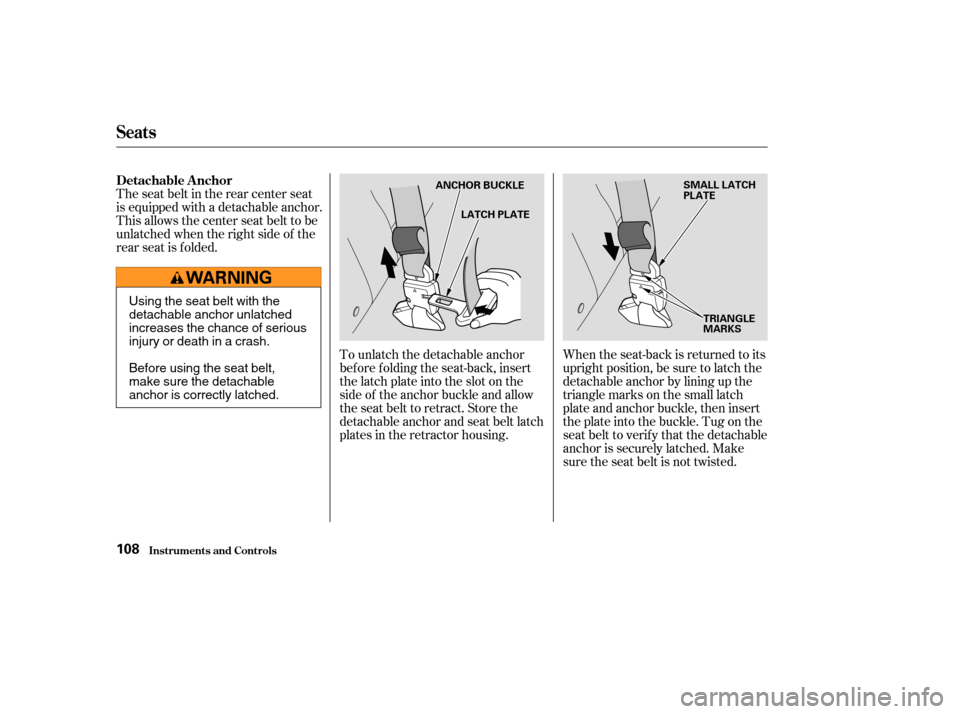Page 112 of 374

The seat belt in the rear center seat
is equipped with a detachable anchor.
This allows the center seat belt to be
unlatched when the right side of the
rear seat is folded.To unlatch the detachable anchor
bef ore f olding the seat-back, insert
the latch plate into the slot on the
side of the anchor buckle and allow
the seat belt to retract. Store the
detachable anchor and seat belt latch
plates in the retractor housing.When the seat-back is returned to its
upright position, be sure to latch the
detachable anchor by lining up the
triangle marks on the small latch
plate and anchor buckle, then insert
the plate into the buckle. Tug on the
seat belt to verify that the detachable
anchor is securely latched. Make
sure the seat belt is not twisted.
Seats
Inst rument s and Cont rols
Detachable A nchor
108
ANCHOR BUCKLE
LATCH PLATE SMALL LATCH
PLATE
TRIANGLE
MARKS
Using the seat belt with the
detachable anchor unlatched
increases the chance of serious
injury or death in a crash.
Before using the seat belt,
make sure the detachable
anchor is correctly latched.
Page 191 of 374
If you can open the hood without
lifting the hood latch handle, or the
hood latch handle moves stif f ly or
does not spring back as bef ore, the
mechanism should be cleaned and
lubricated (see page ).To close the hood, lif t it up slightly to
remove the support rod f rom the
hole. Put the support rod back into
its holding clip. Lower the hood to
about a f oot (30 cm) above the
fender,thenletitdrop.
After closing the hood, make sure it
is securely latched.
Pull the support rod out of its clip
and insert the end into the hole in
the hood.
3.
266
CONT INUED
Service Station Procedures
Bef ore Driving187
CLIP SUPPORT ROD
Page 199 of 374

Distribute cargo evenly on the
f loor of the cargo area, placing the
heaviest items on the bottom and
as far forward as possible. Tie
down items that could be thrown
about the vehicle during a crash or
sudden stop.
If you carry large items that
prevent you f rom closing the
tailgate or the hatch glass, exhaust
gas can enter the passenger area.
To avoid the possibility of, f ollow the
instructions on page . If you can carry any items on a
roof rack,besurethetotalweight
of the rack and the items does not
exceed the maximum allowable
weight. Please contact your Honda
dealer f or f urther inf ormation.
If you use an accessory roof rack,
the roof rack weight limit may be
lower. Ref er to the inf ormation that
came with your roof rack.
To secure cargo, use the f our f loor
hooks in the cargo area. Make sure
all stored items are secured before
driving.
60
CONT INUED
Carrying Cargo in the Cargo A rea
or on a Roof Rack
carbon
monoxide poisoning
Carrying Cargo
Bef ore Driving195
HOOKS
Page 200 of 374
Store only small, lightweight items in
the pockets on the back of the
tailgate.
To secure cargo, use the f our f loor
hooks in the cargo area. Make sure
all stored items are secured before
driving.
Carrying Cargo
Bef ore Driving
T ailgat e Pocket s
196
TAILGATE POCKETS
TAILGATE POCKETS
Page 203 of 374

Youshoulddothefollowingchecks
and adjustments every day bef ore
you drive your vehicle.Make sure all windows, mirrors,
and outside lights are clean and
unobstructed. Remove f rost, snow,
or ice. Check the adjustment of the seat
(see page ).
Check the adjustment of the
inside and outside mirrors (see
page ).
Check the adjustment of the
steering wheel (see page ).
Fasten your seat belt. Check that
your passengers have f astened
their seat belts (see page ).Turn the ignition switch ON (II).
Check the indicator lights in the
instrument panel.
Start the engine (see page ).
Check the gauges and indicator
lights in the instrument panel (see
page ).
Visually check the tires. If a tire
looks low, use a gauge to check its
pressure.
Check that any items you may be
carrying with you inside are stored
properly or f astened down
securely. Make sure the doors are securely
closed and locked.
Check that the hood, tailgate and
hatch glass are f ully closed.
1.
2.
3.
4. 5.
6.
7.
8.
9.
10.
11.
12.
97
114 83
17 200
65
Driving
Preparing to Drive
199
Page 214 of 374

�µ
Always use the parking brake when
you park your vehicle. The indicator
on the instrument panel shows that
the parking brake is not f ully
released; it does not indicate that the
parking brake is f irmly set. Make
sure the parking brake is set f irmly
or your vehicle may roll if it is
parked on an incline.
If your vehicle has an automatic
transmission, set the parking brake
bef ore you put the transmission in
Park. This keeps the vehicle f rom
moving and putting pressure on the
parking mechanism in the
transmission making it easier to
move the shift lever out of Park
when you want to drive away. If the vehicle is f acing uphill, turn
the f ront wheels away f rom the curb.
If you have a manual transmission,
putitinfirstgear.
If the vehicle is f acing downhill, turn
the f ront wheels toward the curb. If
you have a manual transmission, put
it in reverse gear.
Make sure the parking brake is f ully
released bef ore driving away.
Driving with the parking brake
partially set can overheat or damage
the rear brakes.
Make sure the moonroof and the
windows are closed.
Lock the doors and the tailgate
with the key or the remote
transmitter.
Make sure the hatch glass is
closed securely. Place any packages, valuables, etc.,
in the cargo area or take them
with you. Turn of f the lights.
Never park over dry leaves, tall
grass, or other f lammable
materials. The three way catalytic
converter gets very hot, and could
cause these materials to catch on
fire.
Parking T ips
Driving
Parking
210
Page 223 of 374

The best way to conf irm that vehicle
and trailer weights are within limits
is to have them checked at a public
scale.
Using a suitable scale or a special
tongue load gauge, check the tongue
load the f irst time you set up a
towing combination (a f ully-loaded
vehicle and trailer), then recheck the
tongue load whenever the conditions
change.Towing can require a variety of
equipment, depending on the size of
your trailer, how it will be used, and
how much load you are towing.
Discuss your needs with your trailer
sales or rental agency, and f ollow the
guidelines in the rest of this section.
Also make sure that all equipment is
properly installed and that it meets
f ederal, state, province, and local
regulations.Any hitch used on your vehicle must
be properly bolted to the underbody.
Always use saf ety chains. Make sure
they are secured to both the trailer
and hitch, and that they cross under
the tongue so they can catch the
trailer if it becomes unhitched.
Leave enough slack to allow the
trailer to turn corners easily, but do
not let the chains drag on the ground.
CONT INUED
Checking L oads
T owing Equipment and
A ccessoriesHitches
Saf et y Chains
Towing a Trailer
Driving219
Page 225 of 374

Many states and Canadian provinces
require special outside mirrors when
towing a trailer. Even if they don’t,
you should install special mirrors if
you cannot clearly see behind you, or
if the trailer creates a blind spot.
Askyourtrailersalesorrental
agency if any other items are
recommended or required f or your
towing situation.When preparing to tow, and bef ore
driving away, be sure to check the
f ollowing:
The vehicle has been properly
serviced, and the tires, brakes,
suspension, and cooling system
are in good operating condition. The lights and brakes on your
vehicle and the trailer are working
properly.
The trailer has been properly
serviced and is in good condition.
Allitemsonandinthetrailerare
properly secured and cannot shif t
while you drive. Thehitch,safetychains,andany
other attachments are secure. Your vehicle tires and spare are
properly inf lated (see page ),
and the trailer tires and spare are
inflated as recommended by the
trailer maker.
All weights and loads are within
limits (see pages and ). If you tow f requently, f ollow the
Severe Conditions maintenance
schedule. 217 218 278
Additional Trailer EquipmentPre-T ow Checklist
Towing a Trailer
Driving221